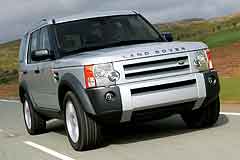
MSRP As Tested: Not Available
Major Options: Rear seat package, navigation system, automatic rear climate control, lighting package, cold climate package.
Fuel Economy (city/hwy): 14/18.
Review
The first motor vehicle, of any type, that two thirds of the world's population will ever see, is a Land Rover. This is because Land Rovers have always been able to go anywhere: on road, off-road, or on unpaved track. This remains the case with the 2005 Land Rover LR3. Now not only can you go anywhere, at any time, you can go in a completely modern automotive design.
The 2005 Land Rover LR3 replaces the Discovery in the U.S, line up, and it is known as the Discovery 3 in the rest of the world. It is the ninth new vehicle introduced during the 56-year history of the company. And it is the first Land Rover product completely developed under Ford's ownership.
LR3 comes in two trim levels, the entry level SE and the more upscale HSE. Both are equipped with a modified version of Jaguar's 4.4 liter, 300-horsepower, V8 engine. A V6 is coming.
It is the first Land Rover to come with a forward facing third row seat. Land Rover felt this was critical for the LR3's market, as SUVs are family-haulers, and no longer vehicles just for navigating regions of the world without paved roads.
Attempting a hill climb at 8:00 am on a cold morning, after a full night of rain, one truly appreciates the power of a capable off-road vehicle. The Land Rover LR3 is just such a machine, and though it never made it up the grade despite three valiant attempts, it nonetheless proved its off-road prowess.
Testing the 2005 LR3 on the Biltmore Estate near Ashville, North Carolina, gave us the opportunity to learn about the incredible technology now in Land Rovers. It also enabled us to see the backwoods of this glorious area, without concern for streams, ice, or mud bogs.
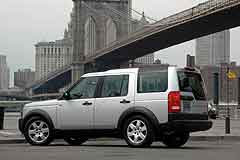
Exterior
The LR3 is a handsome and unconventional design. It replaces the Discovery name in Land Rover's U.S. line-up. While it doesn't look much like the Land Rovers of yesteryear, it is now a thoroughly modern design for techno-savvy drivers fluent in 21st Century styling.
LR3 is substantially a rectangular form. It has straight lines everywhere. However these lines are not sharp, so much as smooth. The gaps between body panels are tight fitting, giving the vehicle a cohesive, minimalist style. It is a great execution of simplicity.
The grille is split by a single thick bar, and framed by the headlights. On the side there is a cut line running from the top of the headlights, under the hood straight back to the front doors. It resumes behind the rear doors tying the front lights to the rear of the car. The roof line steps up to accommodate stadium seating. The vehicle has a unique silhouette that barely hints at the technology inside.
The rear end retains the window shape of the Discovery. But now it contains a split rear tailgate making possible to put stuff in the cargo area by opening just the window.
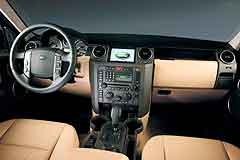
Interior
The LR3 interior is equally as modern as the exterior, and is nonetheless a Land Rover. Luxury SUV amenities like a plush leather are standard. And missing amenities, like door-mounted, water-bottle holders, and front and rear cup holders, are now in ample supply. The numerous cubbyholes, map pockets, nets and gewgaw holders are gone, reflecting the change in the vehicle's targeting; this Land Rover is about 'how you get there' versus 'where you're going.'
One of the best reasons to own an LR3 is the navigation system. It's stellar and worth the extra expense, especially if gizmos are your thing.
It has a fantastic monitor depicting graphics of most of the vehicle's technologies. It shows you what those technologies are doing, and the function they are engaged in. The navsys has a touch-screen interface, voice-actuated directions, and controls for the audio system, all in one. Fantastic!
This system should be standard in every luxury vehicle.
We had plenty of seat time, both in the front and back seats. While driving around the Biltmore Estate, we traded places to experience different types of terrain. All positions are comfortable and supportive holding you in place when the vehicle gets at odd angles - which it definitely can do. And LR3 has stadium seating. Passengers in the rear two rows sit higher giving them a better view of the road ahead.
The rear doors are small and the step up to get into the second row is high. Getting in and out of the rear seats is a little difficult, especially for kids, shorter adults, and people with mobility considerations. Running boards help, but they aren't a good idea if you actually plan to drive the vehicle off road.
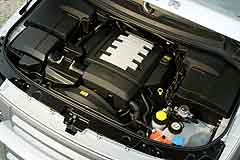
Performance
The LR3 is powered by the same 4.4-liter, V8 engine found in Jaguars. They generate 300-hp and 315 lb-ft of torque at 4,000 rpm. This power plant provides plenty of get-up-and-go for both on, and off-road use. The V8 engine is strong with plenty of torque for pulling the $50,000 truck over most any rock or obstacle. On the highway it is smooth and quiet with plenty of power for passing. A smaller, more gas thrifty, 4.0-liter, V6 engine with 216-hp and 269 lb-ft torque at 3,000 RPM will be available in July 2005.
LR3 is equipped with a 6-speed, electronically-controlled "CommandShift" transmission. It has normal, sport and manual modes useful for the variety of driving conditions Land Rover owners experience, especially on the highway. Permanent all-wheel drive, coupled with traction control provide rugged capabilities, and can come in very handy when the vehicle hits snow, ice, mud or heavy rain.
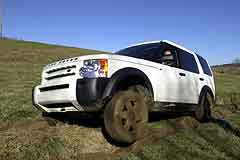
Ride and Handling
LR3 features Land Rover's new Terrain Respons system, which is not yet available on the more expensive Range Rover. The system manages all of the electronic driver-aides including: traction control, stability control, Hill Descent Control and the air suspension (which levels the vehicle and smoothes the ride.) The Terrain Response system provide the driver with maximum control over the vehicle on all most surfaces regardless of conditions.
The driver selects the appropriate setting for the conditions using a rotating knob on the center console. It operates much like the setting mechanism on digital cameras, and the information is displayed on the dash-front monitor. There are five settings to choose from: a general driving program, 'grass/gravel/sno' (for slippery surfaces,) and three special off-road modes: 'mud/ruts', 'sand' and 'rock crawl'.
The trails around the Biltmore Estate, in Asheville North Carolina, afforded an excellent demonstration of the system's capabilities. The driver need only select the surface conditions and the system sets the suspension and controls the vehicle appropriately. It makes moving from one type of driving condition to another interesting, and accurate.
The 4-channel, all-terrain, anti-lock braking system with electronic brake distribution and cornering brake control add to the fun. There are also power-assisted, 4-wheel, ventilated disc brakes all around for great stopping power.
One of our favorite LR3 features is the automatically deploying, hill-descent control - a feature we like to see on any vehicle. On steep hills the system kicks in to control downward speed keeping it below 4 miles per hour. Hill ascent control also prevents the vehicle from rolling backwards in the case that you have to stop on a hill. Try this when parking in San Francisco as it makes getting out of an uphill parking space, on a rainy day, really easy. These are incredibly useful technologies.
The on road drive of the LR3 is excellent compared to luxury SUVs like the Aviator, Envoy, or the Cadillac SRX. But it is not as refined as the Volkswagen Touraeg, or the six-cylinder Cayenne.
Daily commutes on pavement will be comfortable thanks to the LR3s air suspension which, in addition to providing a smooth ride, levels the car. If the rear cargo area has a heavy load the system makes sure that the front wheels stay on the ground, so it is possible to steer. Off road the LR3 is a true Land Rover capable of traversing the toughest terrain, from the Amazon to the mud bogs in your local off-road park.
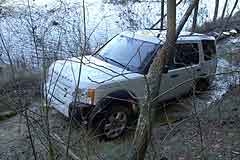
Safety and Security
Airbags are everywhere in the LR3. There are side curtain airbags for first and second row outboard passengers, and side curtains for 3rd row passengers. That is an exclusive feature within this segment.
Rear parking distance control is standard, and a very handy feature to have. The standard keyless entry system has a perimetric sensing security system. This provides additional protection in parking lots and buildings and helps keep thieves from being attracted to the vehicle.
The construction is solid, free from the squeeks and rattles common in most of the competing products. Integrated body-frame, boxed-steel ladder frame, and welded steel monosides make LR3 extra sturdy. Both the front and rear doors have side impact beams for protection. This construction is particularly important in off-road products that might tip over in an extreme maneuver. Add to that Land Rover's unique Terrain Response system. It provides the automatic load leveling component of the air suspension.
In Conclusion
The LR3 competes well with the Volkswagen Touareg on and off road, and both are favorites. The LR3 and Touareg are similarly priced, though the VW has closer-to-Range Rover -performance and luxury.
LR3 is far more capable off road than the BMW X5, Mercedes-Benz M Class, or the Infiniti FX. It will best a Hummer on rough terrain as it is both lighter and a more useful size -- it can fit between more things. It has much better on-road ride than the Nissan Pathfinder, Ford Explorer or any GM SUV, including the Cadillac Escalade. It is also far more hip and chic.
A base V6 version starting at $38,950 will broaden the truck's appeal, and compete with the VW Touraeg, Porsche Cayenne and the BMW X5 six-cylinder versions.
Pros: Great off road capability, good on road manners, fantastic technology, interesting design.
Cons: Boxy styling will get dated quickly, pricey, expensive to repair, we miss the abundance of map pockets .
Ratings (1-10)
Style: 8
Performance: 8
Price: 7
Handling: 8
Ride: 8
Comfort: 8
Quality: 9
Overall: 8
More Data
Base MSRP Range: $38,285 - $49,330
Base Invoice Range: $34,839 - $44,890
Where Built: England
Versions: SE, HSE
Vehicle Category: Mid-Size Luxury SUV
Engine Location: Front Engine
Standard Safety Features: Driver and passenger airbags, Side Curtain Airbags, Seat mounted side airbags, Dynamic Stability Control , Antilock Brake System, electronic brake force distribution, Tire pressure monitor, Electronic Brake Force Distribution.Competition: Volkswagen Touareg, Porsche Cayenne, Mercedes-Benz M Class, BMW X-5, Jeep Grand Cherokee.
Drive Wheels: Four-Wheel Drive.
Engine as Tested: 4.4-liter, Dual Overhead Cam, 32-valves, V-8, 300-horsepower at 5,500 rpm and 315 lb-ft torque at 4,000 rpm.
Transmission As Tested: Six-speed electronically controlled, intelligent automatic with CommandShift manual control.
Seating: 5, 7 with optional rear seat.
Number of Rows: 2. 3 with optional rear seat
Length in Inches: 190.9
Warranties: 4 years/50,000 miles bumper to bumper, 6 years/unlimited miles corrosion protection, 4 years/50,000 miles Roadside assistance.
Weight in Pounds: 5,426 lb./5,796 lb
Cargo Capacity in Pounds: Not available.
Gross Maximum Vehicle Weight in Pounds: 7,121 lb.
Towing Capacity in Pounds: 7,716 lb.
Gas Tank Capacity in Gallons: 22.8
Destination Charge: $665




